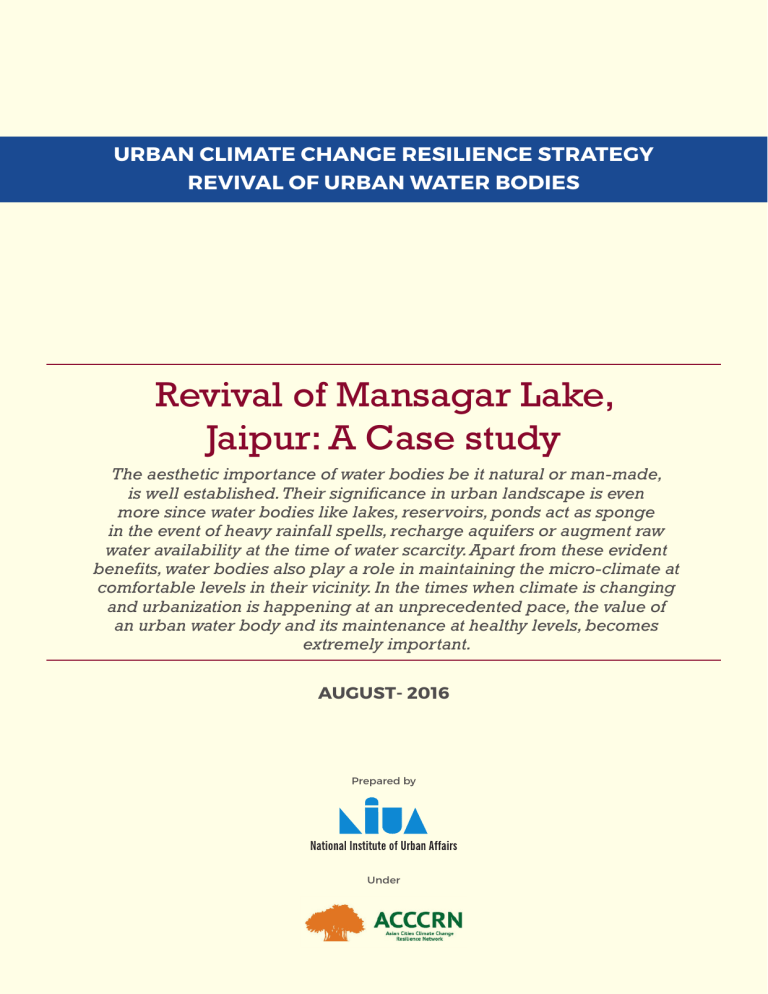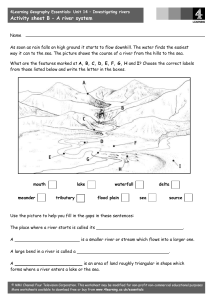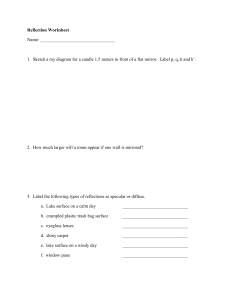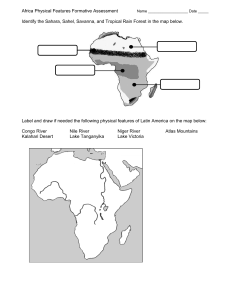
URBAN CLIMATE CHANGE RESILIENCE STRATEGY REVIVAL OF URBAN WATER BODIES Revival of Mansagar Lake, Jaipur: A Case study The aesthetic importance of water bodies be it natural or man-made, is well established. Their significance in urban landscape is even more since water bodies like lakes, reservoirs, ponds act as sponge in the event of heavy rainfall spells, recharge aquifers or augment raw water availability at the time of water scarcity. Apart from these evident benefits, water bodies also play a role in maintaining the micro-climate at comfortable levels in their vicinity. In the times when climate is changing and urbanization is happening at an unprecedented pace, the value of an urban water body and its maintenance at healthy levels, becomes extremely important. AUGUST- 2016 Prepared by Under Due to the process of urbanization, water bodies are lost in oblivion, owing to neglect by concerned authorities and encroachment of water bodies’ catchment by built spaces put to various urban use. Cities rich in history like Jaipur in India have inherited tangible and intangible heritage in the form of buildings, streets, palaces and forts, water bodies (also called Baolies / Jheel) and culture, rituals and customs. Jaipur city on the fourth side (south of the lake). The run-off reaching the lake is carried by - Nagtalai Nala (natural channel) and Brahmapuri drain, covering the 60% of the urbanized catchment area of the lake Mansagar. Heavy pollution load is carried by these drains from this urbanized catchment, which constitutes entire old Pink city of Jaipur and northern portion of modern Jaipur city. Problems which infested the lake This is a documentation of revival of Lake Mansagar from Jaipur, in the state of Rajasthan. The lake remained in good condition till the city of Jaipur was ruled by the maharajas (former city rulers), but the situation became alarming when the Jaipur administration diverted walled city sewage to the lake through the drains Brahampuri nallah and Nagtalai nallah in 1962. Growth of aquatic weed like water hyacinth suppressed the algal growth and added dead organic pollution load leading to decrease in the fish count in the water body 1. A brief about the lake Mansagar Lake is located in the northern part of modern day Jaipur city (see map-1) . The lake was built by Raja Mansingh – I, in the year 1610, who reigned over Amer. The Lake Mansagar was formed in the midst of Nahargarh hills (western side of the lake), Amer hills (northern side of the lake) and Amargarh hills (eastern side of the lake), by constructing a dam on river Darbhawati, to address the drought in the surrounding lands. The height of the dam was increased by Raja Jai Singh – II during his reign (1699-1744), who also founded the city of Jaipur (Pink City), south of this lake. Today, the lake has an area of about 300 acres (1.21 km2). With this the lake became an example of polluted water body, receiving city sewage. The aquatic life of the lake deteriorated and migratory birds stopped arriving to this natural habitat. An unbearable stench emanated from the lake and the lake bed got filled with sewage soaked silt, which posed an environmental and health hazard (see Picture-2). The lake turned into a mosquito breeding ground. Catchment area of Lake Mansagar The catchment area of the lake covers an area of 23 – 24 km2 and has hills surrounding the lake on three sides and the Picture 2: The Mansagar Lake received sewage and apathy of Archaeological Survey of India. Source: Mail Online India, dated 13th October 2012 Turnaround of Lake Mansagar In the year 1999, the state government started working on a strategy to clean up and revive Lake Mansagar as the revival of the lake was linked to environmental and economical benefits. The strategy to restore the lake was based on a public-private model, wherein the private player would clean and maintain the lake and the palace, and the government would lease out 100 acres of land in the vicinity of the lake to the private player to develop it for tourism and recreation activities and recover the invested amount. Map 1: Location of Mansagar in Jaipur Source: Google map, accessed on 7th September 2016 In 2002, the Ministry of Environment and Forests (MoEF), Government of India, appointed the Jaipur Development Authority (JDA) as the nodal agency for Lake Mansagar’s restoration under the National Lake Conservation Plan. In 2004, Jal Mahal Resorts Pvt Ltd., led by Kothari Group, won the bid and were formally engaged by state government in reviving the lake and the palace. In the following year, a 99 year lease agreement was signed between the two parties (at an annual lease amount of Rs. 2.52 crores) with an increase by 10% in the amount every three years. This agreement Picture 1: Jal Mahal in Lake Mansagar Source: http://www.jaipur-travel-guide.com/Jaipur-attractions/Man-Sagar-Lake-Jaipur.html 1“Mansagar Lake: Past, Present and Future” at Taal 2007: The 12th World Lake Conference, by K.P.Sharma 2 ensured maintenance of lake and the infrastructure like Sewage Treatment Plant 2. lake. This source of water, helped in ensuring supply of water to the lake. Before the restoration effort the Mansagar Lake used to dry up in the summer, but it remains perennially full. To attract flora and fauna, five nesting islands (see Picture4) were created to attract migratory birds, fishes were introduced and giant bubblers were installed for aeration of the lake. Steps taken to revive the lake It was a difficult task to clean the lake. The first step taken was to check the sewage and solid waste from entering the lake through drains. A 1.5-km channel was constructed as part of the initiative to divert drain and storm water into a 7-metre-deep sedimentation basin constructed on the east side of the lake (towards dam). This led to the physical screening of water and removal of solid waste and pollutants from the water (primary screening). Simultaneously, second step taken up by the private player was the dredging of the lake bed. This increased the lake’s depth from 1.5 meter to more than 3 meters, which helped in increasing the storage capacity of the lake. Current status of the lake and the surroundings After the revival of Mansagar Lake (see picture 4) it has turned into a tourist spot. Locals and tourists can be seen enjoying evenings on the lake front promenade developed by Jaipur Development Authority, along the Jaipur – Amer road. The lake front also has a museum, hotels and restaurants and is well connected to Jaipur old and new city, by city buses, cabs and auto-rickshaws. The lake has now been added as a picnic spot to the city of Jaipur and is loved by people for the open space and water front. Water sample from the lake indicated that the BiochemicalOxygen Demand (BOD) registered a sharp decline after passing through the sedimentation basin. The BoD going into the sedimentation tank was 450 BOD, but reduced to 25 at the outfall point. The e-coli bacteria in the lake also shrunk from 2.4 million in 2000 to just 7,000 in 2009-113. Apart from these two major steps, several other measures helped in the restoration of the water body. Two sewage treatment plants were also constructed to treat 7 million litres of waste water daily and discharge the treated water into the However, at present that the lake front is not clean (see Picture-5-9). The water at the edges of the lake, near the promenade, is littered and solid waste is visible, which is visually an unpleasant sight. The practice of feeding bread crumbs to fishes in the lake is partly to be blamed for the littering. Lack of dustbins along the promenade, despite a large number of street vendors and food stalls, is another reason for poor solid waste management in the area. Picture 3: The Mansagar Lake after restoration. Picture 5: Promenade along the lake is a picnic spot. Source: NIUA, July 2016 Source: Social Sector Service Delivery: Good practices Resource Book 2015 – by NITI Ayog and UNDP Picture 4: An artificially created island to rejuvenate ecosystem in the lake. Picture 6: Visible garbage along the lake front. Source: NIUA, July 2016 Source: NIUA, July 2016. 2 The Heritage Debate – Ruining a Revival. Tehelka Magazine, Vol 9, Issue 27, Dated 07 July 2012 3 http://archive.tehelka.com/story_main53.asp?filename=Ne070712Coverstory.asp accessed on 03/09/2016 3 Picture 7: Dirty and ill maintained lake front. Jal Mahal visible in the background Source: NIUA, July 2016 Picture 8: Fishes being fed. The plastic waste is strewn around. Source: NIUA, July 2016 Figure 1 illustrates the lake and the characteristics of its immediate catchment area. It shows the areas where solid waste has been found to be strewn along the lake front, indicating lack of maintenance and cleanliness of the area. The figure also shows the diverted drains and sedimentation basin in the lake, which have helped in the restoration of the lake. Vacant plots of land in northern and southern edge of the lake are the result of litigation that arose in the public private partnership in the revival of Lake Mansagar (as discussed in last section). The figure also shows the urban and natural catchment of the lake. Picture 9: Vacant plot of JDA in the northern buffer of the lake Source: NIUA, July 2016 Figure 1: Lake and its catchment area Source: NIUA, author’s illustration. 4 Importance of Lake’s revival in building city’s resilience which it could develop into a tourist hub. The KGK Consortium led by Kothari won the bid to undertake this work. The KGK Consortium was an amalgam of various companies led by Kothari and christened The Jal Mahal Resorts Pvt Ltd. Jaipur (urban area and its surrounding) has lost 60 rivulets out of 518 rivulets due to expanding built-up area in an unplanned manner. More than a 1000 wells/tube wells have completely stopped recharging water due to increase in paved areas between years 1986 to 20074 . Encroachments on natural drains and expansion built spaces is causing flooding during extreme rainfall events, for instance on 20th and 21st August 2012 heavy downpour in Jaipur caused floods leaving the city devastated. Two hours of heavy downpour on the night of the 21st measuring 17 cms caused the flooding in city and claimed 8 lives5 . A similar heavy rainfall event happened in July 1981, when Jaipur received 32cm of rainfall in 24 hours. According to media reports6 , even after using up Rs. 25 crore (Rs.250 million) from the lake fund by the State Government, the lake was left stinking at the time the property was to be handed over to Kothari in 2004. The State Government told the private company that it had done whatever it could, and any further expenditure on lake clean up will have to be done by the company. KGK Consortium appointed a German engineer for the cleanup task. The engineer and his team joined the two nallahs, created a sedimentation basin and dredged the whole lake bed to revive and restore the lake. The team also restored the Jal Mahal. However, when the palace was ready and the lake restored for its first batch of tourists, the High Court issued Non Bail-able Warrants against Navratan Kothari in response to separate criminal cases filed by Bhagwat Gaur, a local lawyer, and heritage activist Ved Prakash Sharma. A University of Rajasthan professor and botanist, K.P. Sharma, filed a third PIL. Chief Justice Arun Mishra clubbed all the three cases and ruled in May 2012 that the lake’s surrounding cannot be altered, pending a resolution of the matter. The lake and local natural drainage act as a buffer and prevent flooding. These natural features facilitate easy discharge of water, which is left standing if the outfall or the natural channel is obstructed. Lake Mansagar offers such environmental services to the northern parts of city of Jaipur. Discussion with residents of a locality to the west of Lake Mansagar, revealed the following: i. Mansagar lake used to supply water to old Jaipur city, when population was small. Later, Ramgarh dam near the city supplied water to the city and today Bisalpur dam supplies water to the city. ii. Rainfall has decreased in the region. Earlier Mansagar used to fill up by rainwater, but not now. iii. Tourist activity is responsible for the garbage and filth deposited in the lake. iv. Water table has risen in the area, but people do not use the water for their domestic use, but use it for cattle. People are aware that the water in the lake is being discharged from sewage treatment plant, and therefore hesitate in using the water for domestic purposes. v. Machines working in the lake to oxygenate the water help in supporting the aquatic life and bird population. vi. Poor maintenance of the lakefront promenade is due to the court case against the private developer. The Litigation which has ruined the development KGK’s legal adviser pointed out that in addition to the initial bid amount of Rs 2.5 crore (Rs. 25 million), the consortium was required to deposit an additional amount every year in an escrow account for 99 years from 2005. In the first three years, this annual amount was Rs 2.5 crore and the contract stipulated that it would be escalated every three years by 10 per cent. So since 2005, KGK had deposited at least Rs 18.75 crores and ‘this money could only be used for the maintenance of the lake’. The restoration was important to enable a hotel to be constructed in its vicinity. Drains flowing into the lake had to be diverted. The state government, which had promised Rs 24 crore for the clean-up, had used the money to develop a promenade around the lake instead of cleaning the lake. KGK spent over Rs 35 cr for the restoration of the lake and the monument. The project, though a very good one, has run into trouble. It is now embroiled in litigation. Following is the extract from different local newspapers which highlights the course of litigation and its consequences: The 372 acre area of the lake is now declared as a protected area through notification released by the Local Self Government Department on July 2015. After this notification many activities in the lake area are restricted – including construction of resort and hotel on the lake periphery7 . In 1999, the state government entered into a partnership with private developer to clean up the Mansagar lake and restore Jal Mahal under a public-private partnership arrangement. The state did its bit to clean up the lake by tapping into the ` 25 crore National Lake Development Fund. The private firm did the rest to restore Jal Mahal and also pay for the annual maintenance of both - the monument and the lake. In return, the company was to get 100 acres in the vicinity of the lake, It is due to this ongoing litigation, the financial sustainability of the project has been affected, resulting in poor maintenance of the lake, areas surrounding the lake and a large prime space lying vacant in Jaipur. It is feared that due to lack of maintenance the benefits accrued from the revival of the lake may start vanishing. It will not only be a loss of architectural jewel like “Jal Mahal”, but a large ecosystem which has multiple benefits for the city of Jaipur. 4 “Impact Of Urbanization On Water Resources : Case Study Of Jaipur” at World Water Congress 2015, by Kamal Narain Joshi 5 “Heaviest rainfall in 31 years floods Jaipur” headline in Times of India newspaper, dated 23rd August 2012. 6 The Heritage Debate – Ruining a Revival. Tehelka Magazine, Vol 9, Issue 27, Dated 07 July 2012 7 “Government declares Jal Mahal, Man Sagar lake protected” headline Times of India, dated 3rd July 2015. 5 20



